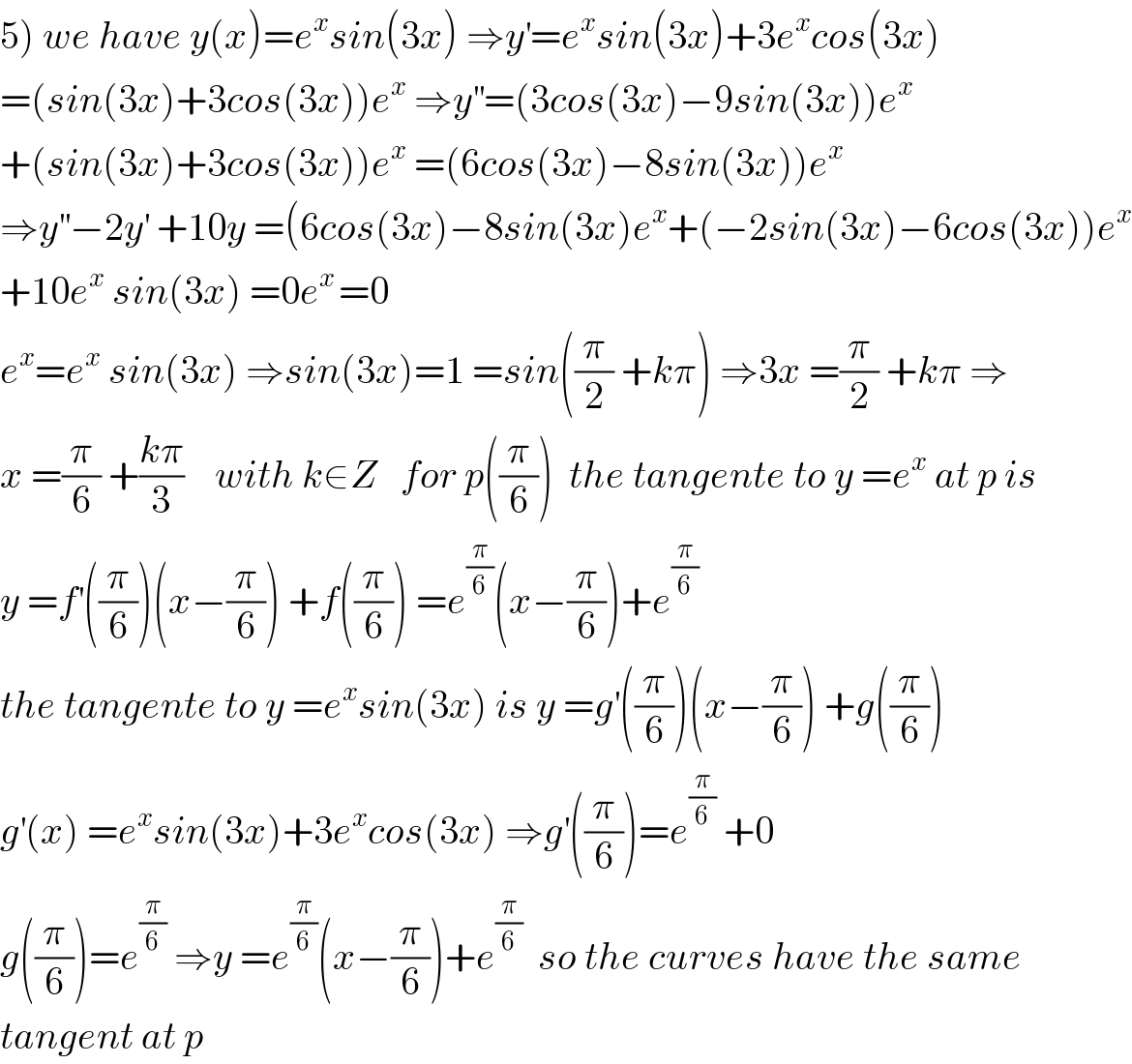
Question Number 69046 by Rio Michael last updated on 18/Sep/19

Commented by mathmax by abdo last updated on 18/Sep/19

$$\left.\mathrm{4}\right){we}\:{have}\:\:{y}={xarctanx}\:\Rightarrow{y}^{'} ={arctanx}\:+\frac{{x}}{\mathrm{1}+{x}^{\mathrm{2}} }\:\Rightarrow \\ $$$$\left({x}+{x}^{\mathrm{3}} \right){y}^{'} −\left(\mathrm{1}+{x}^{\mathrm{2}} \right){y}−{x}^{\mathrm{2}} =\left({x}+{x}^{\mathrm{3}} \right){arctanx}\:\:+{x}^{\mathrm{2}} −\left(\mathrm{1}+{x}^{\mathrm{2}} \right){xarctanx} \\ $$$$−{x}^{\mathrm{2}} =\mathrm{0}\:\Rightarrow\left({x}+{x}^{\mathrm{3}} \right)\:{y}^{'} \:=\left(\mathrm{1}+{x}^{\mathrm{2}} \right){y}+{x}^{\mathrm{2}} \:\Rightarrow{let}\:{derivate} \\ $$$$\left(\mathrm{1}+\mathrm{3}{x}^{\mathrm{2}} \right){y}^{'} \:+\left({x}+{x}^{\mathrm{3}} \right){y}^{''} =\mathrm{2}{x}\:{y}+\left(\mathrm{1}+{x}^{\mathrm{2}} \right){y}^{'} \:+\mathrm{2}{x}\:\Rightarrow \\ $$$$\left({x}+{x}^{\mathrm{3}} \right){y}^{''} \:\:+\left(\mathrm{1}+\mathrm{3}{x}^{\mathrm{2}} −\mathrm{1}−{x}^{\mathrm{2}} \right){y}^{'} \:−\mathrm{2}{xy}\:−\mathrm{2}{x}\:=\mathrm{0}\:\Rightarrow \\ $$$${x}\left(\mathrm{1}+{x}^{\mathrm{2}} \right){y}^{''} \:+\mathrm{2}{x}^{\mathrm{2}} {y}^{'} −\mathrm{2}{x}\left({y}+\mathrm{1}\right)\:=\mathrm{0}\:\Rightarrow \\ $$$$\left(\mathrm{1}+{x}^{\mathrm{2}} \right){y}^{''} \:+\mathrm{2}{xy}^{'} −\mathrm{2}\left({y}+\mathrm{1}\right)\:=\mathrm{0} \\ $$
Commented by Rio Michael last updated on 18/Sep/19

$${thanks}\:{sir} \\ $$
Commented by mathmax by abdo last updated on 18/Sep/19

$$\left.\mathrm{5}\right)\:{we}\:{have}\:{y}\left({x}\right)={e}^{{x}} {sin}\left(\mathrm{3}{x}\right)\:\Rightarrow{y}^{'} ={e}^{{x}} {sin}\left(\mathrm{3}{x}\right)+\mathrm{3}{e}^{{x}} {cos}\left(\mathrm{3}{x}\right) \\ $$$$=\left({sin}\left(\mathrm{3}{x}\right)+\mathrm{3}{cos}\left(\mathrm{3}{x}\right)\right){e}^{{x}} \:\Rightarrow{y}^{''} =\left(\mathrm{3}{cos}\left(\mathrm{3}{x}\right)−\mathrm{9}{sin}\left(\mathrm{3}{x}\right)\right){e}^{{x}} \\ $$$$+\left({sin}\left(\mathrm{3}{x}\right)+\mathrm{3}{cos}\left(\mathrm{3}{x}\right)\right){e}^{{x}} \:=\left(\mathrm{6}{cos}\left(\mathrm{3}{x}\right)−\mathrm{8}{sin}\left(\mathrm{3}{x}\right)\right){e}^{{x}} \\ $$$$\Rightarrow{y}^{''} −\mathrm{2}{y}^{'} \:+\mathrm{10}{y}\:=\left(\mathrm{6}{cos}\left(\mathrm{3}{x}\right)−\mathrm{8}{sin}\left(\mathrm{3}{x}\right){e}^{{x}} +\left(−\mathrm{2}{sin}\left(\mathrm{3}{x}\right)−\mathrm{6}{cos}\left(\mathrm{3}{x}\right)\right){e}^{{x}} \right. \\ $$$$+\mathrm{10}{e}^{{x}} \:{sin}\left(\mathrm{3}{x}\right)\:=\mathrm{0}{e}^{{x}\:} =\mathrm{0} \\ $$$${e}^{{x}} ={e}^{{x}} \:{sin}\left(\mathrm{3}{x}\right)\:\Rightarrow{sin}\left(\mathrm{3}{x}\right)=\mathrm{1}\:={sin}\left(\frac{\pi}{\mathrm{2}}\:+{k}\pi\right)\:\Rightarrow\mathrm{3}{x}\:=\frac{\pi}{\mathrm{2}}\:+{k}\pi\:\Rightarrow \\ $$$${x}\:=\frac{\pi}{\mathrm{6}}\:+\frac{{k}\pi}{\mathrm{3}}\:\:\:\:{with}\:{k}\in{Z}\:\:\:{for}\:{p}\left(\frac{\pi}{\mathrm{6}}\right)\:\:{the}\:{tangente}\:{to}\:{y}\:={e}^{{x}} \:{at}\:{p}\:{is} \\ $$$${y}\:={f}^{'} \left(\frac{\pi}{\mathrm{6}}\right)\left({x}−\frac{\pi}{\mathrm{6}}\right)\:+{f}\left(\frac{\pi}{\mathrm{6}}\right)\:={e}^{\frac{\pi}{\mathrm{6}}} \left({x}−\frac{\pi}{\mathrm{6}}\right)+{e}^{\frac{\pi}{\mathrm{6}}} \\ $$$${the}\:{tangente}\:{to}\:{y}\:={e}^{{x}} {sin}\left(\mathrm{3}{x}\right)\:{is}\:{y}\:={g}^{'} \left(\frac{\pi}{\mathrm{6}}\right)\left({x}−\frac{\pi}{\mathrm{6}}\right)\:+{g}\left(\frac{\pi}{\mathrm{6}}\right) \\ $$$${g}^{'} \left({x}\right)\:={e}^{{x}} {sin}\left(\mathrm{3}{x}\right)+\mathrm{3}{e}^{{x}} {cos}\left(\mathrm{3}{x}\right)\:\Rightarrow{g}^{'} \left(\frac{\pi}{\mathrm{6}}\right)={e}^{\frac{\pi}{\mathrm{6}}} \:+\mathrm{0} \\ $$$${g}\left(\frac{\pi}{\mathrm{6}}\right)={e}^{\frac{\pi}{\mathrm{6}}} \:\Rightarrow{y}\:={e}^{\frac{\pi}{\mathrm{6}}} \left({x}−\frac{\pi}{\mathrm{6}}\right)+{e}^{\frac{\pi}{\mathrm{6}}} \:\:{so}\:{the}\:{curves}\:{have}\:{the}\:{same} \\ $$$${tangent}\:{at}\:{p} \\ $$
Commented by mathmax by abdo last updated on 18/Sep/19

$${you}\:{are}\:{welcome}. \\ $$
